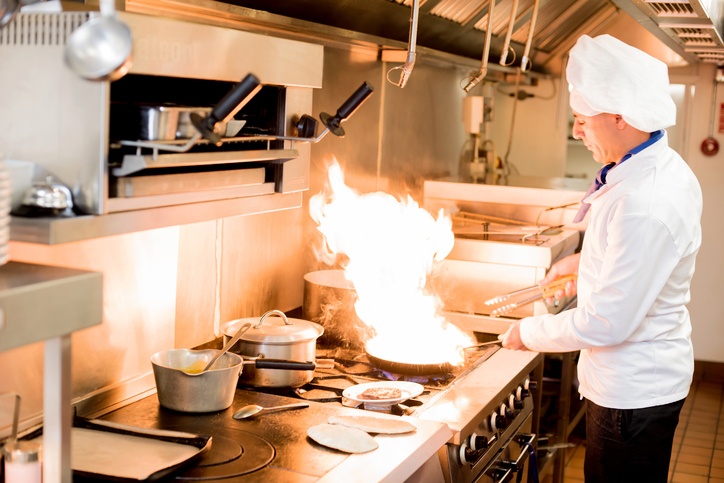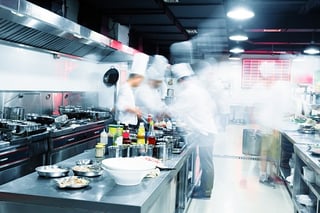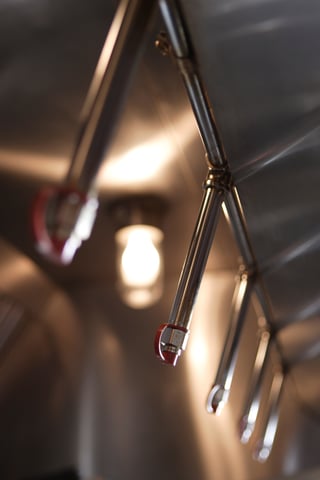
According to the National Fire Protection Association (NFPA), there were 7,640 structural fires in eating and drinking establishments between 2006 and 2010. That may not seem like a big number when you consider all the restaurants in operation in the U.S. today. However, those fires resulted in $246 million in property damage.
More recent data from the Federal Emergency Management Administration (FEMA) for restaurant fires from 2011-2013 shows that on average, a fire in a commercial kitchen will result in an average loss of $23,000. For about 43 percent of those restaurants, that fire shut them down for good.
Thanks to fire safety regulations and advances in fire suppression technology, fatalities are far less common than they used to be. However, property losses due to kitchen fires continue to underscore the need for kitchen owners to:
- Fully understand the fire hazards and implement the training their kitchen staff need to minimize the risk of fire, and
- Have a properly designed fire suppression system that is inspected and maintained on a regular basis.
Understanding Fire Hazards in Restaurant Kitchens
Commercial kitchens pose a unique kind of fire risk with people hustling and bustling in crowded spaces with open flames, lots of heat, and plenty of combustible material.
According to a recent FEMA report, cooking was by far the leading cause of non-residential building fires from 2006-2015 and appears to be on the rise. This is not surprising. Two of the most common and obvious cooking-related fire hazards in commercial kitchens include:
Grease Traps – Grease is a given in any commercial kitchen and is highly combustible. Grease traps, which can contain large amounts of it near heated equipment can present a significant fire hazard.
Exhaust Hoods and Ductwork – While most fires start in and on the cooking appliances, the exhaust hoods and ductwork combined with the airflow can turn a minor fire into a major one. The residue that can build up in a kitchen exhaust system becomes combustible at approximately 700 degrees Fahrenheit. Flare-ups that occur on cooking appliances can often reach more than 1,800 degrees, igniting the grease residues within a hood and quickly spreading throughout the entire duct system.
There are also many other less obvious fire hazards present in commercial kitchens, such as:
- Heated food preparation equipment that is left unsupervised during operation
- Failure to turn off cooking appliances when not in use
- Overheating of oils in fryers, which can lead to spontaneous combustion
- Clutter in the kitchen, such as boxes containing paper goods (food boxes, cups, wrappers, etc.), which are all highly combustible
- Every piece of cloth in the kitchen, including the clothing your staff is wearing, dish towels, pot holders, etc., is a potential fire hazard if it comes in contact with an open flame or heated appliance
Cleanliness in a commercial kitchen is not only important for preparing food that is safe to eat -- it’s also important for fire safety. For example, failing to clean grease traps on a regular basis can leave bits of food that can easily catch fire when more hot grease is added to the trap. And, ovens should be regularly cleaned to remove any buildup of combustible substances.

Making sure your staff recognizes these and other hazards and having safety procedures in place to address them will go a long way to avoiding fires in your kitchen. In addition, ensuring that every person working in your kitchen has a firm understanding of how your fire suppression system works and has adequate training in how to operate a fire extinguisher is critical to keeping everyone safe if a fire does break out.
The way your kitchen is designed may also present other hazards that training and safety procedures alone cannot address and which are easy to overlook. For example,
- How crowded is your kitchen? Do your workers have easy, uncluttered access between workstations?
- Do you have adequate ventilation for the size of your kitchen and the type of cooking you do?
- Are your ovens situated far enough away from other heated equipment to avoid heat transfer from one to the other?
- Are your grease removal devices too close to a heat source?
These are just a few of the things a kitchen owner has to think of when it comes to fire safety. Given the high stakes associated with kitchen fires and the disastrous effect they can have on your business, having a full understanding of your risks is key to mitigating them. Fortunately, you don’t have to figure that out on your own. Koorsen’s fire experts can help with a free, on-site and comprehensive hazard analysis of your kitchen that will provide actionable information you can use to minimize your risk of fire.
Making Sure Your Kitchen Fire Suppression System Will Work when You Need It

Having a properly designed fire suppression system is an essential component of keeping your kitchen and the people that work in it safe. However, it isn't enough to have a kitchen fire suppression system -- it needs to be maintained to ensure it will work when you need it.
Proper maintenance starts with regular inspections because they reveal problems with your system that could impact its reliability. The worst time to find out that your fire suppression system doesn’t work is when fire breaks out in your kitchen. Regular inspections will help you avoid this by identifying problems and giving you the opportunity to address them in a timely manner.
Aside from being required, regular inspections can reveal risks that might otherwise go unnoticed, such as:
- Electrical equipment that may be overheating
- Problems with electrical wiring of appliances
- Faulty installation of fire suppression systems
- Poorly operating detection devices or a lack of detection device or fault-detecting equipment
In addition to these issues, all fire protection systems have “wear” items – parts that must be replaced from time to time, such as rubber blow-off caps, fusible links, etc. Regular inspections ensure that this type of maintenance is performed when needed.
Regular inspection and maintenance is required by the 2017 Edition of the National Fire Protection Association (NFPA) 17A, Standard for Wet Chemical Extinguishing Systems is critical to keep your system in good working order. Other important regulations related to fire safety in commercial kitchens are NFPA 96 Standard for Ventilation Control and Fire Protection of Commercial Cooking Operations and NFPA 10 Standards for Portable Fire Extinguishers.
Koorsen’s Fire Experts Are Here to Help
Koorsen’s fire experts are trained – and offer training – in all manufacturers' systems. So, no matter what type of kitchen fire suppression system you have in your kitchen, Koorsen can help you keep it in good working order. We are also a distributor for all major manufacturers, which means we can easily find the parts you need when you need them. As a distributor, we also have immediate access to recall information and any new technical bulletins published for your system to help you keep it up to date.
You have a lot invested in your business – contact Koorsen today to schedule an inspection of your system or to take advantage of our free, on-site hazard analysis.


